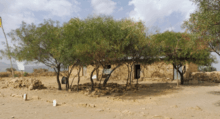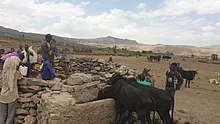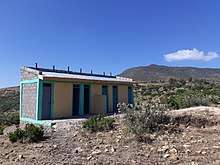Zerfenti school
Zerfenti School is a public school for pre-schooling (grade 0) and grades 1 through 8 in Zerfenti, Addi Azmera, Dogu’a Tembien, Tigray, Ethiopia.[2]
| Zerfenti school ዘርፍንቲ ቤት ትምህርቲ | |
|---|---|
 | |
| Location | |
 Zerfenti school | |
Zerfenti Addi Azmera municipality , | |
| Coordinates | 13.6373°N 39.2987°E |
| Information | |
| Type | Public School |
| School district | Dogu’a Tembien |
| Staff | 12 teachers |
| Grades | 1 – 8 |
| Gender | Co-Educational |
| Number of students | 350 |
| Language | Tigrinya, English |
| Data pertaining to | 2019[1] |
Description


The Zerfenti School has 5 class rooms in stone buildings. As of 2019, the school had 350 students, 184 girls and 166 boys.[2] There were:
- 36 students in one class in Grade 0
- 56 students in one class in Grade 1
- 49 students in one class in Grade 2
- 39 students in one class in Grade 3
- 41 students in one class in Grade 4
- 38 students in one class in Grade 5
- 34 students in one class in Grade 6
- 30 students in one class in Grade 7
- 28 students in one class in Grade 8
Over the last 20 years, important efforts have been done to increase schooling in Tigray, particularly of girls.[3] The large intake in primary schools in Ethiopia over the last decades has led to lack of classrooms.[4] Hence, classes take place through shifts (morning and afternoon).
Water and sanitation
In 2018, there was no water available on the school terrain. They used water from the village hand-dug well with handpump.


There is a change room for girls handling menstrual hygiene;[2] the main aim is preventing adolescent girls dropping out from school.[5][6][7] Up to 2018, there was no toilet building.[2]

In 2019, the School WatSani project has built an Ecosan toilet building at this school.[8][9] Through nudging approach, the students are sensitised for using the sanitation and water facilities.[8]
Transportation
All children travel to school on foot. Many students will walk more than an hour (some even two hours), twice a day, to come to school.[2]
See also
- Education in Ethiopia
- List of schools by country
- List of universities and colleges in Ethiopia
References
- Jeroen Berloo, 2019. Update to baseline study about water and sanitation in eight selected schools by the project ‘School – Watsani’ in the Woreda Dogu’a Tembien. HOWest, Bruges, Belgium.
- Goele Treuttens and Linde Van Der Vurst, 2018. Baseline study about water and sanitation in ten selected schools by the project ‘School – Watsani’ and in the community around the schools in ten different villages in the Woreda Dogu’a Tembien. HOWest, Bruges, Belgium.
- Mjaaland, T., 2013. At the frontiers of change? Women and girls’ pursuit of education in north-western Tigray, Ethiopia. The University of Bergen. http://bora.uib.no/handle/1956/6361
- Hartjen, C.A. and Priyadarsini, S., 2012. Denial of Education. In The Global Victimization of Children (pp. 271-321). Springer, Boston, MA. https://link.springer.com/chapter/10.1007/978-1-4614-2179-5_8 .
- Wilberg, J., 2004. Female education in Tigray, Ethiopia. UMB, Norway. p. 104 http://www.umb.no/statisk/noragric/publications/master/2004_jeanett_wilberg.pdf
- Socio-demographic profile, food insecurity and food-aid based response. In: Geo-trekking in Ethiopia's Tropical Mountains - The Dogu'a Tembien District. SpringerNature. 2019. ISBN 978-3-030-04954-6.
- What do we hear from the farmers in Dogu'a Tembien? [in Tigrinya]. Hagere Selam, Ethiopia. 2016. p. 100.
- Griet Verrewaere, 2019. Report of latrine use and behaviour amongst students - The nudging approach at School-Watsani. HOWest, Bruges, Belgium.
- Reubens, B. and colleagues (2019). Research-Based Development Projects in Dogu'a Tembien. In: Geo-trekking in Ethiopia's Tropical Mountains — The Dogu'a Tembien District. SpringerNature. doi:10.1007/978-3-030-04955-3_30. ISBN 978-3-030-04954-6.